Revealing the least known but arguably best 1960s 20″ wheel shopper
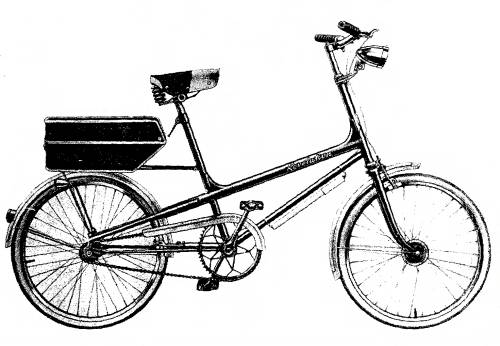
In the mid 1960s, in response to the unexpected success of the Moulton bicycle, most UK cycle manufacturers launched unsprung unisex small-wheelers. Although Raleigh and a few others initially adopted 16″ diameter wheels, it was the 20″ wheel open-frame ‘shopper’ that was to be most successful commercially. Dawes, with its Newpin/Kingpin range was perhaps the first major maker to adopt the 20″ wheel, using both the British 20 x 1 3/8″ (ISO 451) and the French 500A (ISO 440) formats. The Raleigh 20 range was ultimately the best seller. But perhaps the best of the 20″ wheel open frame machines was the least well known – the Royal Enfield Revelation.
Royal Enfield came into being in the 1890s. The Eadie Manufacturing Company of Redditch, Worcestershire [about 12 miles south of central Birmingham] obtained a contract for supplying precision rifle parts to the Royal Small Arms factory in Enfield, Middlesex. Eadie’s product range included bicycles. They renamed these ‘Royal Enfield’ to capitalise on the firearms association and adopted the slogan ‘Built Like A Gun.’ An international rally to celebrate a hundred years of Enfield cycles was held at Redditch in August 1992.
The Royal Enfield Revelation was the last machine designed and built at Redditch. The designer was the late Vic Bott, who was born c.1900 and lived until the 1990s. He joined Royal Enfield in 1920 and remained with them until the final shutdown in 1968. In 1946 he was presented with the Long Service Certificate shown below.
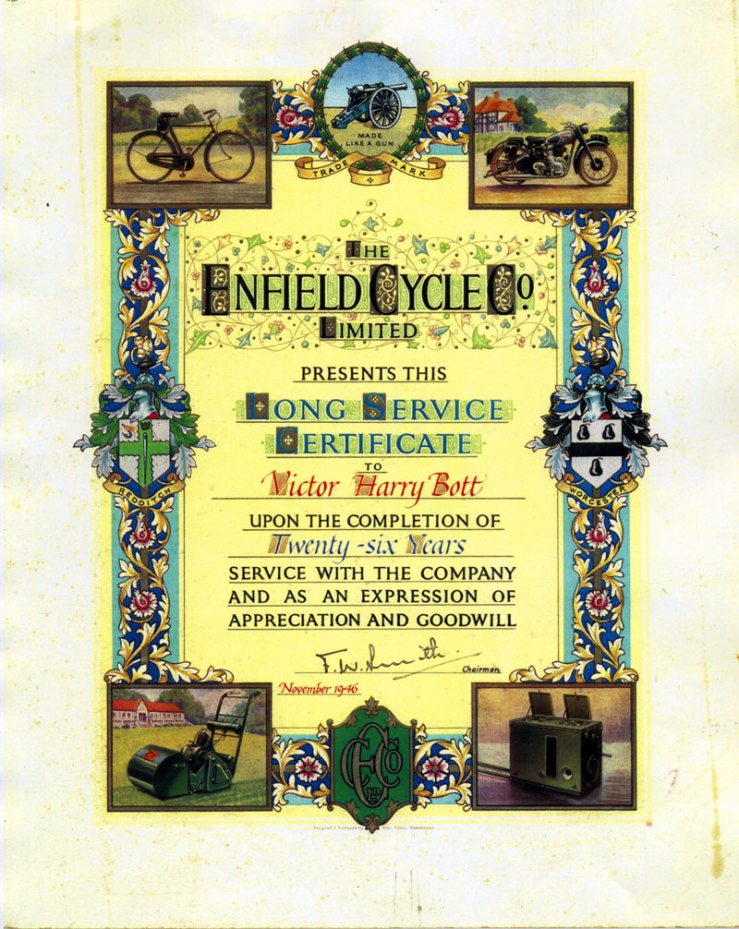
Thanks to Anne Bradford, author of ‘The Royal Enfield Story,’ we have Vic’s reminiscences of the Revelation’s genesis. To these have been added dates [in square brackets thus] supplied by Malcolm Barrett, Royal Enfield marque enthusiast of the Veteran-Cycle Club:
‘When Mr Davenport, Mr Cassey and Mr Roberts arrived from E & H P Smith to take over the running of the company [1962], I had a surprise because I knew Leo Davenport. I had met him way back in the early days of Royal Enfield, not long after the First World War, when he was a representative for Lodge Plugs and riding in the TT for AJS – his father was a manager there. We heard that E & H P Smith were amalgamating with Royal Enfield and we thought that we would be the senior partners but it soon became clear that E & H P Smith were in charge. Leo Davenport took over Vic Mountford’s splendid office and Vic was moved to a more humble abode down the corridor.”I was due for retirement but when the time came, E & H P Smith offered us an increase in salary and so I decided to continue to work. A couple of years later [1964], Leo Davenport sent for me. He said that he wanted to put a cycle on the market with a 20″ wheel and asked me if I could design it. He wanted to know how soon I could have a prototype ready. Jokingly, I said, “Two weeks!” and he jumped at that. I knew I had landed myself with a problem. It usually took years to develop a new bicycle. It was clear that I couldn’t go through the customary design channels so what I did, was that I laid an enormous piece of paper on the floor, drew a profile of the bike to size and gave it to the Design Department to build. Within a week, a girl was trying out the cycle by riding it to Stratford. [Stratford-upon-Avon, about 11 miles away.] After that, of course, all kinds of tests had to be made to make sure that the bike was safe but within twelve months [1965] it was on sale in the shops. The bicycle was called “The Revelation”.’
Dave Wilson worked in the toolroom and tooled up the unusual gussets that reinforce the junctions between the top tube and the head and seat tubes. He recalls seeing rows and rows of Revelations in the despatch department before he left the company early in 1965.
It is unclear how many Revelations were made: Vic Bott told Anne Bradford that they sold ‘thousands’ but Arthur Beckingham, the works foreman (and allegedly ‘last to leave the factory’ when it closed) told Tony Hadland in 1991 that they made only between 30 and 100, which seems improbably low. The lowest and highest serial numbers traced as at 2022 (134,426-158,835) are 24,409 apart. However, it is unclear whether Royal Enfield used a single numbering sequence for all their models or a separate series for the Revelation.
(One of the highest numbered machines was bought shop-soiled from the factory on 30 June 1967. It was said to have been used for an abortive sponsored ride from the factory to Australia, which got no further than Dover. The purchaser was an aunt of Veteran-Cycle Club member Paul Kimberley. )
Arthur Beckingham was born c.1920, joined Enfield at the age of 14 and, apart from military service and illness, spent the whole of his working life with the company. He told Tony that Enfield had previously prototyped a small-wheeler with a single main beam of about 2″ diameter. However, it seems this was not mass-produced and no other reference to this earlier prototype has been found.
The Revelation was claimed by its makers to have ‘the same wheelbase as the normal cycle’ and to be ‘20% lighter than the normal machine.’ The recommended prices, c.1966, including purchase tax, were: £24 11s 2d (£24.56) for the single-speed version, £27 4s 6d (£27.23) for the version with Sturmey-Archer AW 3-speed, and £30 5s 4d (£30.27) for the version with the 3-speed and a Sturmey-Archer GH6 Dynohub lighting set. This latter version competed for sales head-to-head with Raleigh’s RSW16 and was virtually the same price.
All Revelations were supplied with a Moulton-style holdall for the well integrated but removable rear carrier. A frame-fixed front carrier, which again showed strong Moulton influence, was an optional extra: this had a recommended retail price £1 10s 4d (£1.52) including purchase tax. The unisex frame covered the range 18″ to 23″ and was catalogued as being available in ‘flamboyant burgundy’ or ‘flamboyant blue.’ It was also supplied in green, although no catalogue reference to this colour has yet been found. Tyres were all-white Dunlops in the British 20 x 1 3/8″ (ISO 451) format.
The bicycle came with a short white plastic pump, tools, reflector on the rear mudguard, propstand and ‘top run’ (‘hockey stick’) chain-guard. Components were typical of British 1960s light roadsters, mostly in steel: see the exploded drawing and parts list below, which come from the spare parts leaflet.

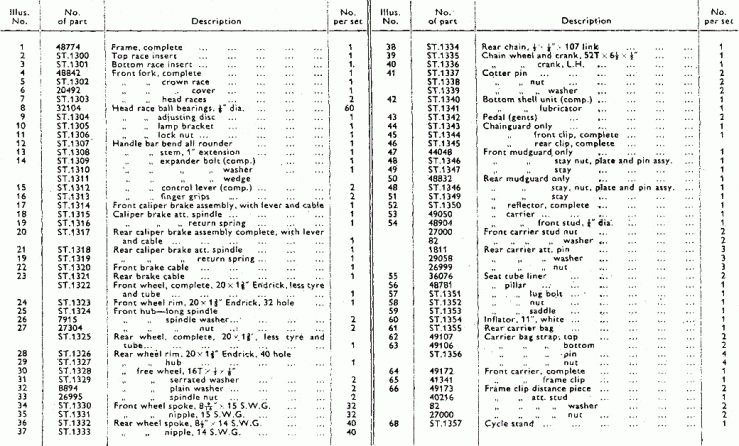
The full model name was the ‘Revelation LHD Mark 1.’ LHD stood for Leo H Davenport, a fact confirmed to Malcolm Barrett by Rex Wearing, formerly company accountant for E & H P Smith and who worked closely with Davenport.
In 1967, the Enfield Cycle Company ceased trading, the Redditch workforce being made redundant on 31st January. The Royal Enfield bicycle brand name was sold and the model name Revelation was subsequently applied to a less interesting small-wheeler sold elsewhere as a Vindec. (Vindec was a brand name used by Brown Brothers.)
The pictures below show the designer, various surviving machines, advertising material and photographs of the Revelation being built at Redditch. We hope you enjoy it. If you have further information about this bicycle, please contact Tony Hadland via this blog.
Below are two technical drawings by Vic Bott of what appears to be a prototype child’s small-wheeler. These, and the certificate above, were kindly provided to Malcom Barrett by a nephew of Vic Bott.

Picture courtesy of Malcolm Barrett.

Picture courtesy of Malcolm Barrett.

Picture by Tony Hadland.

Picture by Tony Hadland.
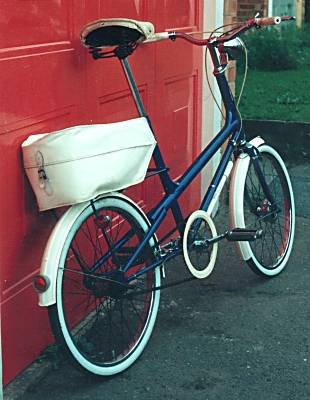
Picture by Tony Hadland.

Catalogue courtesy of Malcolm Barrett.

Brochure courtesy of John Pinkerton.

Cutting from Tony Hadland.

Cutting from Tony Hadland.

Cutting courtesy of Malcolm Barrett.

Picture courtesy of Malcolm Barrett.

Picture courtesy of Malcolm Barrett.
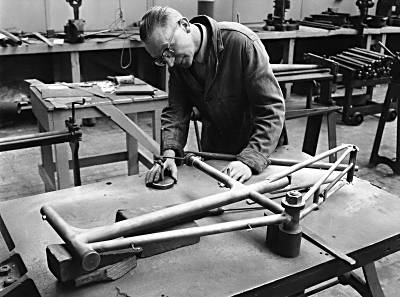
Picture courtesy of Malcolm Barrett.

Picture courtesy of Malcolm Barrett.

Picture courtesy of Malcolm Barrett.

Picture courtesy of Malcolm Barrett.

Picture courtesy of Malcolm Barrett.
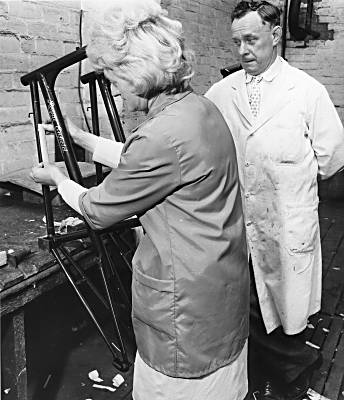
Picture courtesy of Malcolm Barrett.
Article first published in 2001. Last updated 30th January 2023. Tony Hadland thanks John Ivins, John Pinkerton, Anne Bradford, Barry Smith, David Vann, Paul Kimberley, Arthur Beckingham and particularly Malcolm Barrett for information contributed to this article.
Herbert Kuner read the above article and wrote:
I’m researching the history of the Dutch bicycle industry, and so I discovered that the model ‘New Fashion’ made by Batavus in the ’60s is a virtually complete copy of the Revelation.
In November 1965 the Dutch bicycle dealer’s trade magazine F4 announced a bicycle with a ‘completely new design for Holland’: the 18″, 20″ or 24″ wheeled Batavus New Fashion. On my website, there is a non-official page where you can find pictures of a 1967 New Fashion: http://www.rijwiel.net/fietsen/bat/f50653.htm. In the same magazine in February 1966, there is even a new, foldable version of the New Fashion mentioned. I enquired at Batavus about who designed the New Fashion. Some older Batavus employees, the son of the old Batavus director Gerrit Gaastra, Andries Gaastra (who himself was commercial director of Batavus between 1967-73 and later founded the brand Koga Miyata) and the former financial director of Batavus all said that – as far as they remember – the New Fashion was designed by Gerrit Gaastra (who died in 1997). Reading your article on the Royal Enfield Revelation which seems to be marketed at least a few months earlier, I think this is impossible.
Moreover, I discovered the RE Revelation in the 1966 catalogue of Simplex, another well-know Dutch bicycle manufacturer. This was the true Royal Enfield model, imported to Holland. The Amsterdam bicycle wholesaler Westor originally imported Royal Enfield bicycles, but was taken over by Simplex by 1 November 1965. That is how the Revelation could appear in the Simplex catalogue.
I collected a lot of data about old Dutch bicycles (mainly from the ’50s and ’60s) to compile a bicycle database with approximately 5,000 bicycles. Not one is a RE Revelation, and there are only 5 Batavus New Fashions, all of them with 24″ wheels and not foldable. Even Andries Gaastra doesn’t know anything about the claimed foldable version. So my conclusion is that the 24″ non-foldable New Fashion was the only version sold in relevant numbers, and the RE Revelation was offered only for a short period and sold in very little numbers.
Kind regards,
Herbert Kuner
Utrecht, Holland
www.rijwiel.net
Demonchaux’s Revelation copy
In February 2011, James Thomson kindly pointed out that Demonchaux have been making a machine plainly inspired by the Revelation. The main differences seem to be in wheel format and front fork design. There are many more pictures of variants of the Demonchaux version here: www.flickr.com/photos/demonchaux/
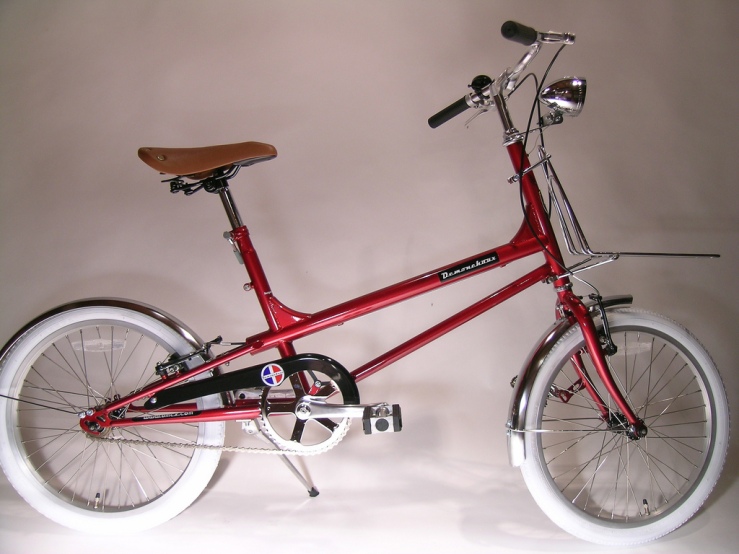


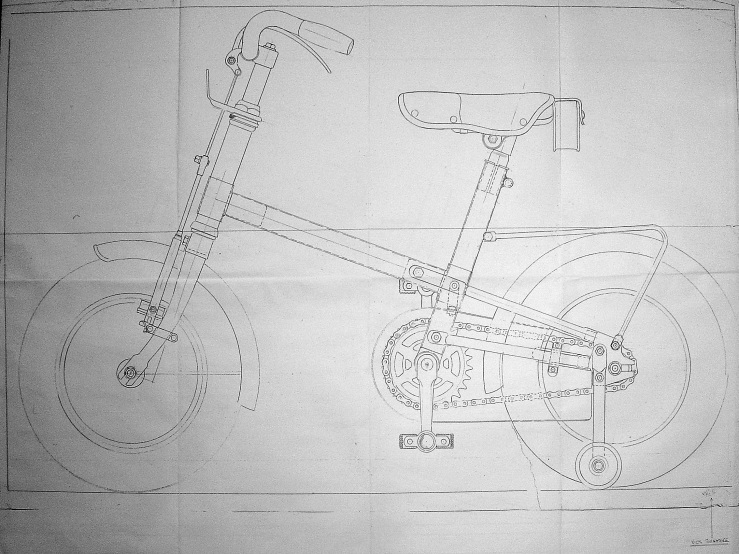
Hi Tony, I have 3 revelations for sale. I wondered if you could put me in touch with anyone who would like them?
Hi Roy,
I think your best bet is to publicise your three bikes on the Revelation Facebook page: https://www.facebook.com/groups/682470355189995/
Cheers,
Tony
Might be interested Roy, whats your location.
I have put together a register of serial numbers and hub dates if you would like to send them over. (alao the bikes colour)
Cheers John
Very interested Roy. Im running a register if you coukd send ovee the serial numbers, hub date and colour.
Would be interested in buyingbthe bikes also.
Cheers John.
Hi Roy, I’m interested in one, if they are available. I don’t have a facebook account though.
Best,
Duncan
I had a Royal Enfield Revelation in 1967, in Beautiful Red. My Nan bought it for me.
I really wanted the Moulton because of its suspension, but Nan said it was more expensive, but in the end I got used to it, and really loved being out on it.
I found a sturdy metal shopping basket near the local supermarket, and I fitted it to the back carrier, I was a paperboy. I would just throw my heavy paper bag into to the basket and ride off. All the other paperboys/girls watched me race off, while they had to carry their bags.
I am now 71 and still go cycling. I have a Raleigh evo2 which is a bit heavier than other cycles, but it is really strong.
An evocative piece of Revelation-related nostalgia, Mike. Many thanks!
Tony
[…] the main interest for Brown Brothers in the purchase was the Royal Enfield Revelation shopper bike (see the history of the Revelation on Tony Hadland’s blog) which had been a low key success for the Enfield Cycle Co. Brown Brothers subsequently offered the […]
Interesting to learn about the Royal Enfield Harrier hi-rise bike.
Tony
Hello Tony.
Just been sent a new number for the Register I’m keeping on the ROYAL Enfield Revelation FB page.
158835, 1967, Green.
This currently makes this bike the last known production bike.
Hi John,
That’s interesting – many thanks!
Tony
Hello Tony
I have had my Royal Enfield Revelation since it was new in 1966. Then aged 9, the deal was to save up to pay half the cost ( from memory it was about £27 new) and my parents would pay the balance! I really wanted the Raleigh with the small ‘balloon’ wheels but my mechanically minded engineer Dad decided the Revelation was a far superior bike! The rest is history. This bike grew up with me and eventually travelled on the train with me to Aberdeen in my student days in the 1970s. It was replaced by my still current mountain bike in 1996 but the Revelation, now almost 60 yrs old is still stored in the garage! It’s serial number is 151427, in its orinially royal blue colour and is still in reasonable condition for its age. It has the SA 3 gears, with dynamo front and rear lights, and is in good working order. The mud guards, saddle, tyres, chain guard and handle bar rubber ‘holds’ have been replaced but the rest is original. The rear bag (navy) was disposed of many years ago but I still have the original white pump!
You may like to add this one to your list. I am amazed to discover there is so much interest in these rare bikes!
Kind regards
Kay
Hi Kay,
Thank you very much for this. It’s fascinating to hear your reminiscences and great to know that you still have the bike in such an original condition.
Tony
Hi Tony
I have read that there is a date somewhere on the hub but have so far not found it. Can you tell me exactly where it is located please?
Two cousins also had this same bike – one burgundy and one blue – but sadly theirs no longer exist.
Out of interest how many, still in existence, do you have on your list? And did you ever discover how many were originally produced?
Thanks
Kay
Hi Kay,
The Sturmey-Archer 3-speed hub is dated in the format 64 10, where 64 denotes 1964 and 10 is October. Actual date of construction of the bike would be a little later, depending on how many hubs Royal Enfield bought at a time and how many they kept in store.
As for the number of these bikes made, I can only reiterate what I say in the article on my website/blog:
“It is unclear how many Revelations were made: Vic Bott told Anne Bradford that they sold ‘thousands’ but Arthur Beckingham, the works foreman (and allegedly ‘last to leave the factory’ when it closed) told Tony Hadland in 1991 that they made only between 30 and 100, which seems improbably low. The lowest and highest serial numbers traced as at 2021 (134,426-156,651) are 22,225 apart. However, it is unclear whether Royal Enfield used a single numbering sequence for all their models or a separate series for the Revelation.”
I’m not the keeper of the register but please see the message below from John Gough. He may be able to assist you.
I hope this helps a little!
Tony
Hi Tony
Many thanks for confirming the location of the date. I’ve just checked it to discover my bike was dated 67 8. I guessed 1966 earlier so wasn’t too far out!
apologies for the delay in replying but have only just picked up your email having been away for a couple of weeks. Many thanks for your help.
Regards
Kay
Glad to have been of assistance, Kay.
Cheers,
Tony
Hi Tony
I really enjoyed reading this. I have the Burgundy 3 speed Dyno Revelation. Lovely well built bike and still very relevant and ridden today. Serial no. 140537. Thank you.
I’m glad you enjoyed the article and that you still enjoy riding your Revelation.
Cheers,
Tony
Hello Tony.
I’m presently trying to get a register of all the Revelations known on the Royal Enfield Revelation Facebook page.
Not always easy as it’s only as good as the info provided
A few differences crop up over the years (rear rack style and decal style being the main two)
Sometimes the hub dates and frame numbers don’t quite match but that’s comman in bike manufacturing I find.
Pop over and have a look.
Yours John.
Well done, John. I’m sorry that I cannot access the register but I no longer have a Facebook account. This is because I don’t trust the company an inch after one of their shocking data breaches enabled a third party to access my wife’s Facebook account, change the password and lock her out. Facebook refuses to either restore her access or take her pages down. This is despite the Consumer’s Association intervening on her behalf. As a matter of principle, and because their security standards are so lax, I closed my own account.
Hi Tony
I was inspired to find my first bicycle, a Royal Enfield Revelation c.1965. After posting lots of searches online I was rewarded a couple of years later with one for sale in St Albans. A Mk1 1965 in my original bikes colour of burgundy. I was in Australia at the time and was able to purchase the said bike and then travel up from Dorset upon return to UK.
It is in original condition and by the looks of it had been stored with little use for years. The rear pannier fasteners are a little age hardened but everything else in top condition. I will replace tyres but apart from that enjoy the bicycle around our mill in SW France.
It does not look like a front rack was ever fitted so I am guessing this was an after market accessory?
The label on the Sturmey Archer gear change lever is missing so I will look out for a replacement.
Your information on the bicycle was invaluable and I thank you very much.
Kind regards
Mark
Great news, Mark – and I’m delighted that you found the info on my site useful.
Cheers,
Tony
Tony
Just found out that the front frame emblem is missing. Can you post a picture to show me what they look like?
Thank you
Mark
Hi Mark,
Sorry – all my Revelation pictures are on the website and, due to lack of space, my Revelation went to a museum, so I can’t help at present. But I’m sure if you ask the Revelation group on Facebook someone will be able to help.
By the way, the front rack was indeed an optional extra but they are rare as hen’s teeth!
Good luck!
Tony
I have a Revelation which I purchased some years ago, apart from some new tyres,plus making it fit to ride my plans to have it painted and upgraded for long rides have not materialized.
As it’s unlikely that will happen I feel I would like it to go to someone who would enjoy restoring it to it’s former glory, as it truly deserves.
Kind regards,
John
Thanks for this, John – I hope you find a good home for the bike. Have you mentioned it on the Revelation Facebook group?
Cheers,
Tony
Thanks for your reply Tony, I have now been inspired to look at the bike again and maybe carry on with my plans for it. I did actually go to some length to find it and get it delivered in the first place.
The frame number is 150748 and the three speed hub is stamped 65.
It has been hand painted but the original colour was a really attractive blue where I have exposed it. Would there be a similar colour used from a car that would be a match.
The bottom bracket was pitted and I put in a square taper one inside the sleeve and an alloy chainset with smaller ring.
The original seatpost with its reducers I replaced with an alloy one which involve removing the internal ridge from the seamed pipe.
The handlebars, stem and levers though present I have replace with alloy to give me a more suitable riding position.
I will attempt a longish ride on it when the weather improves and hopefully that will fully rekindle my enthusiasm for it.
Thank you for this website,without it the history of 20 inch wheel British bikes would not be so well documented.
Thanks very much for this, John. Good luck with the project and it would be interesting to hear how it progresses.
Cheers,
Tony
Hi Tony,an even earlier example has come to light.A friend has recently bought 137181, it’s in a bit of a state but it will be saved. Regards Sean.
Hi Sean,
Great news – many thanks for the update! I have now incorporated the new number into the text of the article.
Cheers,
Tony
Hi,
Thanks for this excellent post. I have had my eye out for a revelation frame for some time, but as you point out the numbers made could be very small.
If anyone has any old revelation frames they are interested in selling please do get in touch as I’m looking for a restoration project.
Regards,
Duncan
Dear Tony,
If possible, could you compare the Dawes Kingpin and the Royal Enfield?
I have never had a Royal Enfield, but have cycled extensively on tour with the Dawes, and have found it a uniquely-robust, stiff cycle of its type.
If the Royal Enfield is better, how?
Cheers,
JIm Berger
Auckland NZ
Hi Jim,
Good to hear from you. The riding experience will be quite similar but I don’t currently possess examples of both for an A-B comparison.
The Revelation is a stiff bike (aided by gusseted joints and a triangulated front end to the frame) and I think the wheelbase is a bit longer than the Dawes. My recollection is that the steering is not as quick/twitchy as some small wheelers. Whether you consider that good or bad may be a matter of taste.
Both the Dawes and the Revelation frames are somewhat more elegant than the Raleigh 20 series, and I personally think the Revelation is the more elegant of the two. However, the Raleigh is exceptionally stiff and, according to Consumers’ Association tests, was stronger than the Dawes. I suspect the Raleigh is also a tad stronger than the Revelation but I don’t think the Consumers’ Association ever tested the latter.
However, I’m talking about the UK-built Raleigh 20s and not the NZ licence-built ones which lack the twin braces that are continuations of the chainstays, wrapped around the bottom bracket and connecting to the underside of the main beam.
The Revelation was never made in a folding or separable version, which is worth bearing in mind.
I would suggest you put your interesting question to the Revelation Facebook group. I think there may be one of two members who own both Revelations and Kingpins. Their thoughts should be worth hearing.
Cheers,
Tony
Dear Tony,
Perhaps the English Raleigh 20’s were more robust, extra gussets, etc, than the ones I have seen, in the USA and in NZ. ..
Otherwise, the Dawes are obviously the superior, stiffer, frames. But, who knows? I’ve been very happy with the Dawes. Just wish I had a co-habitating partner to take another tour with, with such machines…last one was in the Dordogne, late summer of 2006, a month criss-crossing the region, the most wonderul tour of my life.
The cycles are ready, in the garage, but my wife of some 44 years chooses to live down the hill, independently, since 2010…practicing pyschotherapy and helping troubled souls (one hopes…).
Oh, well..she still asks me to maintain her Moulton AM…and I still love her more than anyone in the world…
Changing subjects…for some time, I was experiencing problems with my city cycle, with its AW SA gears…they worked fine, when applying pressure on acceleration, but freewheeling often caused the chain to wrap up. Anyway, when I took the hub apart, I noticed that the sun gear, which was pinned to the axle, like most older ones, had some play, due to the pin not being tight.
When I replaced the entire axle with a newer one, with a fixed sun gear (integral with the axle), the problem went away.
As a long time (+50 years) SA user, I had assumed that the AW was nearly-indestructible..as it is, if tolerances are maintained within reasonable levels!
Finally…have you any more books in the pipeline?
Cheers,
Jim
\
Hi Jim,
The Raleigh 20s sold in New Zealand were locally built under licence and had a smaller diameter main beam which was not braced to the bottom bracket. The Nottingham-built machines sold in the UK and North America were altogether stronger. See this article and look carefully at the pictures of how the British-built R20’s chainstays are flattened, wrapped round and brazed to the bottom bracket shell and extended as twin parallel braces to the main beam:
https://hadland.wordpress.com/2015/04/06/economically-upcycling-a-1978-bsa-raleigh-20-folder/
By way of comparison, see this article which, inter alia (or should that be inter Raleigha?) deals with the NZ R20s:
https://hadland.wordpress.com/2012/07/01/new-zealand-bikes-of-the-1980s/
The rigidity and robustness of the Raleigh 20 made it a favourite for certain well-informed US-based cycle experts, such as the late Sheldon Brown and John S. Allen, to hot up: https://www.sheldonbrown.com/raleigh-twenty.html
Turning to your question about books, my most recent bicycle book is From Bicycle to Superbike by yours truly and Mike Burrows. A slightly revised version of MIT Press’s Bicycle Design: an illustrated history, co-authored with Prof. Hans-Erhard Lessing, is due out shortly. I’ve also just edited an article by Prof. Lessing on the birth of the Draisine for Cycling monthly, the magazine of what used to be the CTC and is now Cycling England. I’ve also researched and written a paper on George Wilson and Raleigh in the Irish Free State for the International Cycling History Conference at Mannheim in June. I was recently consultant for a recent BBC4 TV documentary on Raleigh. And I’ve just published, via the V-CC YouTube channel, a three-part audio interview with John Emery, a great cyclist who trained with Tom Simpson in the 1960s, was involved in testing and prototyping the early Moultons, who won many races thereafter and who has recently got interested in Moultons again.
Nothing else bikewise in the pipeline but I am committed to a major transcription and translation project involving old Oxfordshire church records (mostly in Latin). This is at the behest of the Oxfordshire Records Society and should result in three quite hefty hardbacks. There’s about two to three years of full-time work involved. Needless to say, it’s unpaid – but it interests me!
All the best,
Tony
Dear Tony,
The Raleigh 20’s that I saw in Boston, in the ’70’s and ’80’s, looked pretty flimsy when compared to the Dawes. Don’t recall any extra gussets…and the hinge was definitely inferior to the Dawes.
Anyway, I’ve had some wonderful French tours on my Dawes 5-speed, a donkey of a bicycle, but sure-footed!
Sheldon Brown was a personal friend of mine, once upon a time. I purchased a beautiful 25″ Motebecane frame (bright yellow) from him, once…when I had lovingly completed the assemblage into my then- ultimate 30-speed touring cycle, it was immediately wrecked when my wife drove our car, with the cycle on the roof rack, under a motel roof in Gettysburg, Pennsylvania….and my best recollection of a Raleigh 20 was of his, viewed outside the original “Bicycle Exchange,” near Harvard Square…where I purchased innumerable SA parts and a wonderful Raleigh 531-tubed cycle for my wife, back in the late ’70’s.
Anyway too late to change horses, I now have enough Moultons and Dawes for several lifetimes…and, at 67, not very much of even one lifetime left…still, as the Grateful Dead, my favourite rock group of all time encapsulated in song…”What A Long, Strange Trip, It’s Been…”!
Thank goodness, so much of it has been on a bicycle.
Every day, even cycling in Auckland City, I have true joy in the experience.
Cheers,
Jim
P.S. When/what is your next book?
That’s a tragic tale about the roof rack, Jim, but so easily done. I long ago gave up carrying bikes on the roofs of cars.
In answer to your query, the next book will be the first volume of the transcription and translation of church registers that I mentioned in my earlier reply. I don’t imagine they are of much interest to you but if they are, please email me (tony.hadland@gmail.com) as they are rather off subject for this strand of my website/blog!
Cheers,
Tony
Dear Tony,
You are right, English church registers are not (yet!) an interest that we share.
However, we are all interested in different things, and, if we live long enough, everyone acquires wonderful, unique knowledge, about their passions…a shame that one (usually) can’t assure the survival of all that experience…
Besides bicycles, I am a life-long collector of musical recordings of most genres…for awhile, it was rational, but with some 31,000 albums of rock, blues, jazz, classical, country, pop, etc. (no rap, thank you…!), it is to the point that most of my music, I will never have the time to play again…but I do have it documented, in a database, and it does surface from time to time when something reminds me of a wonderful song, or version thereof.
For example, tonight, I have just finished another compilation of one of my favorite rock songs, and probably no one else in the world could have achieved the exact mix of versions, certainly not without a huge amount of time on-line…it helps to have the library of such, in-house!
Today, I am not a big vinyl fan, most of my stuff is in cd and computer form. (Having said that, I do have all the some 2,000 vinyl albums that I started buying in 1966…)
If music is also your passion, and you are ever looking for something, let me know, if I don’t have it, I can probably get it.
As an example, my local Brit friend has kindly shared with me ALL the obscure Brit prog rock of the ’60’s & ’70’s…as well as all the more well-known Brit music, the Pink Floyds, etc.
Anyway, should you ever publish another cycling book, please do let me know, I wouldn’t want to miss out!
Cheers,
Jim
Hi Jim,
That’s most kind. In fact, I was a disc jockey in my younger days. About 1968, I was the first DJ to be allowed to advertise in the upmarket ‘Country Life’ magazine. I worked on the UK’s first quadrophonic mobile disco (all studio-quality gear). I compered the Who at a concert in Oxford on the day Pinball Wizard was released. I was a freelance contributor on pop and rock music to Belgian (Flemish) national radio for two years and co-hosted a TV show in Brussels in 1973 featuring all British groups including Queen, who at the time were almost unknown in Britain. For Belgian radio I interviewed about two dozen British album artistes. I was also a contributor to BBC Radio Oxford and BBC Radio London, and I did a lot of voiceovers and station IDs for the latter.
All the best,
Tony
Dear Tony,
Interestingly, my local Brit friend was once a DJ in Brighton, before joining the RAF, and for the past 30 years or so, the NZ Air Force, for his permanent gig.
Anyway, should you ever want to revisit Walrus, Wild Turkey, Starry Eyed & Laughing, or similar, you know where to come.
Myself, of all that obscurity, I most prefer a group called the Dark…
http://www.allmusic.com/album/round-the-edges-mw0000454182
More popular and accepted, I love the Pentangle, Free, the Who, Fairport, and I adore Richard Thompson….
Good night for now!
Jim
http://www.allmusic.com/album/round-the-edges-mw0000454182
Hi, I have no idea how old this post is but I have a “revelation” frame no.156651 in dark green with some evidence of fine gold lining. The front forks and rear rack are there but not much else!
If you or anyone you know would be interested ,I would like to move it on to someone who would build it back to its former glory. Please email me if interested.
very best regards Jim.
Thanks James – yours seems to be the highest frame number yet recorded.
Tony
Hi Tony
Not sure how often you check the FB group, so thought I’d drop you a note about another Rev that has surfaced.
I collected today from Brigg, an ebay purchase. Serial number 150533 and rear hub marks 66 4.
Its all there except the head badge and chain guard. Its been well used, but not abused, so I’m very pleased with it.
I’ll be cleaning it up tomorrow. The plan is to modernise with alloy rims, longer (alloy) seat post, alloy stem and bars. The seat is not original and will be replaced with a leather one, probably Spa Cycles Nidd. All bits will be stored so it could be reverted to as-bought. I will be posting progress on the FB group.
Cheers
Graham
Many thanks for this, Graham. I try to keep reasonably au fait with the Revelation activities and always find the restorations interesting. Good luck with your latest one!
Cheers,
Tony
Hi Tony,
I’m trying to work out the model of a bicycle I have. The badge has disappeared but I’m fairly sure it is a late production Royal Enfield. The frame number is 155677 which would make it of the same vintage roughly as these Revelations. Would you have a link to more pictures of the catalogue that lists 12 models?
Many thanks
Patrick
Hi Patrick,
I don’t have access to the information at present but hope to look it up in a week or two.
Cheers,
Tony
Hi again Patrick,
I’ve now had a look for the catalogue but I don’t have a copy. It belonged to a Veteran-Cycle Club (V-CC) member whom I believe died some time ago. The V-CC’s online library has no Enfield catalogue covering the period in question.
However, it might be worth asking on the Royal Enfield Revelation Facebook group whether anyone has that catalogue. Or you could drop a line (enclosing an SAE) to the V-CC’s Enfield marque specialist: Ian Maddams, 11 London Road, Saffron Walden, CB11 4ED.
Cheers,
Tony
Great article Tony,very informative and most interesting.I rode a friends Revelation a few years ago and was amazed how solid it felt,more akin to a diamond frame roadster than an open frame bike.So i decided to look out for one.A couple of weeks ago i found one on ebay,in a job lot of old shopper bikes for next to nothing,Result.I’ve just checked the frame and hub numbers,the hub was stamped 7/65,this had me thinking it must be quite an early one.The frame number is 137415,so i guess thats 15 units earlier than the oldest known survivor.Have i got the oldest Revelation? Kindest regards Sean.
Hi Sean,
Many thanks for your message. Yes, sounds like you might have the oldest Revelation we know of. I’ll amend the article accordingly!
Cheers,
Tony
Hi Tony,
I’d like to thank-you for posting this information. You’ve inspired me to search, buy & restore my own ‘Revelation’. I was searching for a Dawes Kingpin but I believe the aesthetics of the Royal Rev. is more beautiful and until I stumbled onto your blog, I had no idea they even existed! It’s going to be very difficult finding one as I’m in Brisbane Australia so any potential contacts you may have would help me out a great deal! Thanks again, you have a new follower.
Hi Dan,
Yes, they are nice looking bikes but pretty rare. Probably the best place to try, apart from eBay, is the Sales & Wants section of the Veteran-Cycle CLub’s magazine, News & Views. I got my Rev via a contact in the V-CC.
Tony
Hi Tony, great resource here and much appreciated!
I’m looking at the possibility of building a bike for myself, similar to the revelation. Do you know if geometry numbers and specs for the revelation are available anywhere? I’m curious in particular about chainstay length, wheelbase, head angle, rake (or trail), and seat tube angle.
Hi Troy,
Many thanks for your kind words. I don’t have any precise listing of the geometry but you should be able to scale off fairly accurately from the side view of the machine. The overall wheel diameter will be very close to 521mm (451mm bead seat diameter plus 2 x 35mm for the tyre). So if you were to print out the side elevational photo, preferably at enlarged size, you could then measure the wheel diameter on the print and derive a conversion factor based on the fact that the real thing is 521mm. You could then apply that factor to all other dimensions.
The ideal thing, of course, would be to measure an actual bike. Sadly, I don’t own one at present (lack of space), so if anybody reading this can help, please get in touch.
Tony
I have a RE Revelation which I bought on ebay for about £50. Upgraded to Sturmey archer hub brakes and modern 5 speed. It makes a rather good touring bike. In May I rode it from John O Groats back to Bristol via Arran, a 900 mile route which also took in the Royal Enfield pub in Redditch (no free pint after 800 miles!).

Serial number of mine is 140488 and the rear hub was dated Dec 66. I believe the original paint was Blue but it has at some point been red, then a really bad lime green paint job. The original rack and mudguards were discarded by a previous owner so it now sports Balsa and oak veneer mudguards and a cut down Portland design works bamboo topped aluminium rear rack.
That’s very cool, Russell – thanks for sharing it. Great picture, too.
Tony
Dear Tony
I have just purchased a Royal Enfield Revelation for just under £19 on eBay. My original intention was to buy a small ‘theft-proof’ bicycle to use for around 18 weeks when I return to University in September but I have fallen in love with it and am keen to restore it.. I would like to know more about its history but there is limited information on the internet and I was hoping that you might be able to help me.
I have found a number on the main frame: 73824 which I took to be the seriel number but this does not seem to tally with an article on the internet that suggests that the seriel number falls between 137430-151727. Please could you tell me where I can find the seriel number and how I may identify the year of manufacture?
Also, if you have any tips on how I might (as a complete novice) begin to restore it, I would be very grateful!
With kindest regards
S-J
Hi Sarah-Jayne,
Any chance you could email me a photo of the bike, please? Email to tony.hadland@gmail.com
Assuming it has its original rear wheel and a Sturmey-Archer 3-speed in it, you will find a year (2 digits, such as “65”, for 1965) and month indication (e.g. 11 for November) on the shell of the hub. The date of manufacture of the bike will usually be soon after the date on the hub gear shell.
All the best,
Tony
Dear Tony,
I’ve enjoyed your recent blogs/emails.
You and I have corresponded before.
I am the NZ owner of a Raleigh Paratrooper… amongst a few other things.
I have never seen a Royal Enfield small-wheeled cycle, either in my native USA or here.
The schematic makes it look quite elegant, really pretty.
I long since (since my tour of the Azores, in the ’70’s), standardized on the Dawes Kingpin as “the little donkey that can” cycle, for overseas trips.
The Dawes is easily separated for shipping by air, and I can verify that it is very sturdy, and very stiff, for a small-wheeled cycle.
I have compared it with the Raleigh 20, and would never choose the Raleigh 20…
I most recently spent a month in the Dordogne, in 2006, with a much-modified Kingpin, and will have it – and an original 1980’s Moulton AM – also much modified – buried with me in another 30 years or so!
Cheers,
Jim
P.S. Should you ever come to NZ for any reason, and need a place to stay, I’ve got several spare bedrooms, here in central AK.
Hi Jim,
Good to hear from you and thank you for the kind offer of accommodation and for the interesting information. Ah, the Dordogne…
You may be aware that the NZ-produced Raleigh 20s differed from the British-made ones, especially inasmuch that the two braces from bottom bracket to main beam were omitted. I would not be happy about that!
As you may have deduced, I’m in the process of moving material from my old website to the blog, which is so much easier to manage. More stuff will be transferred over the coming weeks, as and when time permits.
Thanks again for your email and hopefully we will meet up some time.
All the best,
Tony